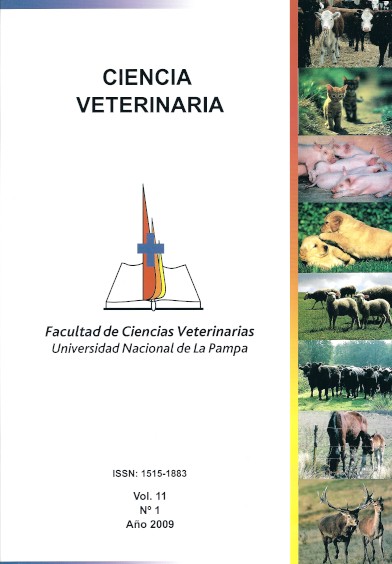Hypomagnesaemia in a beef cattle herd of Caldenal area
Keywords:
Hypomagnesaemia, Beef cowsAbstract
The objective of this trial was to study the serum magnesium (Mg) levels in a beefcow herd of a farm of the "caldenal" pampas zone (Argentina), and mineral concentrations in forage and drinking water. We worked with a herd of 440 Aberdeen Angus beef cows, in a farm of 2.500 has, located in Loventué department, province of La Pampa (36º 31' S, 65º 59' O). The animals grazed native pasture in winter and Eragrostis curvula the rest of the year, and they drank water coming of two 50 m wells. To the survey, 24 cows were randomly allotted and jugular blood samples were collected four times at year,once in each season, from November 2006 to june 2009. The forage was also sampled at the same time. Mg concentration in blood and Mg, calcium (Ca), sodium (Na) and potassium (K) levels in forage were measured. Also, chemical analysis of water was performed, and the mean values were:Total dissolved solids: 918 mg/L, Ca: 56 mg/L, Mg: 30 mg/L and Na: 230 mg/L. The lowest Mg serum values were found in winter (1,31 + 0,28 mg/dl), even the season x year interaction was significative (P0.05). The hypomagnesaemia detected in animals was primary, due to low forage Mg. The levels of K, main antagonist of rumen Mg absorption, were not elevated, and, then, "tetanizing" potentials were normal. Although Na forage concentration was low, water contributed to meet daily requirements of Na. Hypomagnesemia is a metabolic-nutritional disease seasonally presented, from late winter to early spring, but in this case it was detected all the year. Possibly, this is caused by the scarce seasonal variations in Mg forage concentrations. Annual mortality was low (1 to 1.4 %). It can suggest adequate manage of stocking rate and grazing of "problem" farm areas, associated to years of low rainfall, wich reduced the growth of potentially dangerous species, such as Stipa tenuis. In view of this situation, it appears reasonable to implement Mg and Na oral supplementation practices, in order to avoid risks associated with hypomagnesaemia.Downloads
Downloads
Published
How to Cite
Issue
Section
License
Al momento de enviar sus contribuciones, los colaboradores deberán declarar , de manera fehaciente, que poseen el permiso del archivo o repositorio donde se obtuvieron los documentos que se anexan al trabajo, cualquiera sea su formato (manuscritos inéditos, imágenes, archivos audiovisuales, etc.), permiso que los autoriza a publicarlos y reproducirlos, liberando a la revista y sus editores de toda responsabilidad o reclamo de terceros , los autores deben adherir a la licencia Creative Commons denominada “Atribución - No Comercial CC BY-NC-SA”, mediante la cual el autor permite copiar, reproducir, distribuir, comunicar públicamente la obra y generar obras derivadas, siempre y cuando se cite y reconozca al autor original. No se permite, sin embargo, utilizar la obra con fines comerciales.




.jpg)

4.png)


7.png)



